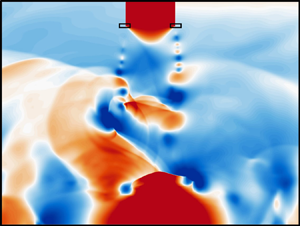No CrossRef data available.
Article contents
A data-driven approach to guide supersonic impinging jet control
Published online by Cambridge University Press: 27 December 2023
Abstract

A data-driven framework using snapshots of an uncontrolled flow is proposed to identify, and subsequently demonstrate, effective control strategies for different objectives in supersonic impinging jets. The open-loop, feed-forward control approach, based on a dynamic mode decomposition reduced-order model (DMD-ROM), computes forcing receptivity in an economical manner by projecting flow and actuator-specific forcing snapshots onto a reduced subspace and then evolving the dynamics forwards in time. Since it effectively determines a linear response around the unsteady flow in the time domain, the method differs materially from typical techniques that use steady basic states, such as stability or input–output approaches that employ linearized Navier–Stokes operators in the frequency domain. The method presented naturally accounts for factors inherent to the snapshot basis, including configuration complexity and flow parameters such as Reynolds number. Furthermore, gain metrics calculated in the reduced subspace facilitate rapid assessments of flow sensitivities to a wide range of forcing parameters, from which optimal actuator inputs may be selected and results confirmed in scale-resolved simulations or experiments. The DMD-ROM approach is demonstrated from two different perspectives. The first concerns asymptotic feedback resonance, where the effects of harmonic pressure forcing are estimated and verified with nonlinear simulations using a blowing–suction actuator. The second examines time-local behaviour within critical feedback events, where the phase of actuation becomes important. For this, a conditional space–time mode is used to identify the optimal forcing phase that minimizes convective instability growth within the resonance cycle.
JFM classification
- Type
- JFM Rapids
- Information
- Copyright
- © The Author(s), 2023. Published by Cambridge University Press





